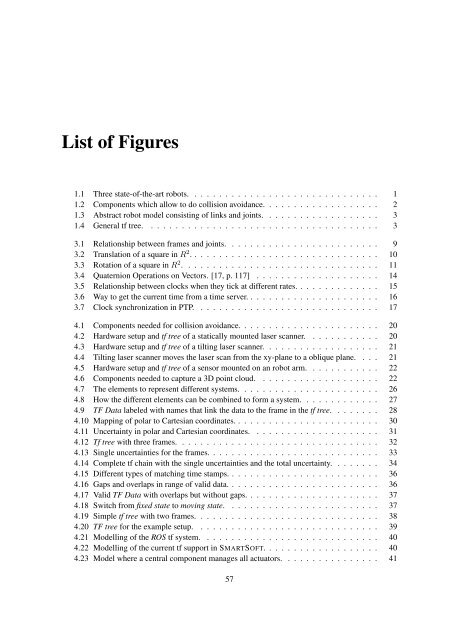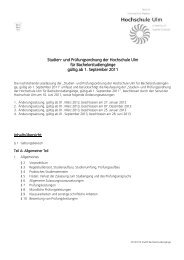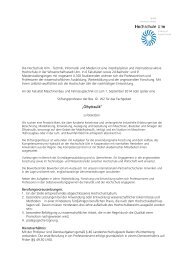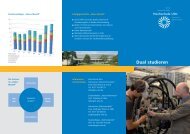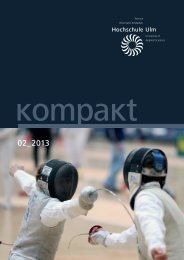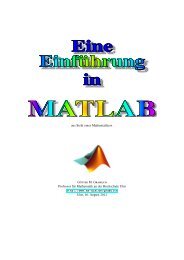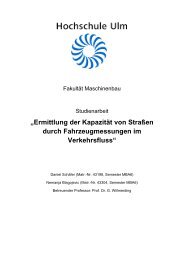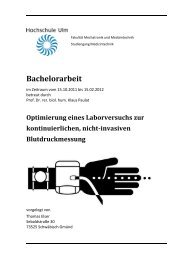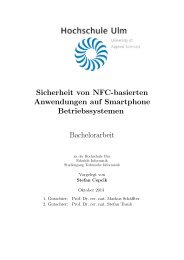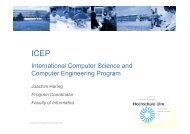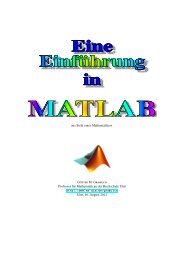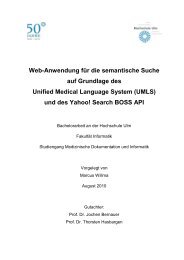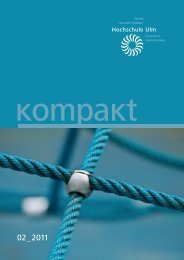PDF 1.938kB
PDF 1.938kB
PDF 1.938kB
Create successful ePaper yourself
Turn your PDF publications into a flip-book with our unique Google optimized e-Paper software.
List of Figures<br />
1.1 Three state-of-the-art robots. . . . . . . . . . . . . . . . . . . . . . . . . . . . . . . 1<br />
1.2 Components which allow to do collision avoidance. . . . . . . . . . . . . . . . . . . 2<br />
1.3 Abstract robot model consisting of links and joints. . . . . . . . . . . . . . . . . . . 3<br />
1.4 General tf tree. . . . . . . . . . . . . . . . . . . . . . . . . . . . . . . . . . . . . . 3<br />
3.1 Relationship between frames and joints. . . . . . . . . . . . . . . . . . . . . . . . . 9<br />
3.2 Translation of a square in R 2 . . . . . . . . . . . . . . . . . . . . . . . . . . . . . . . 10<br />
3.3 Rotation of a square in R 2 . . . . . . . . . . . . . . . . . . . . . . . . . . . . . . . . 11<br />
3.4 Quaternion Operations on Vectors. [17, p. 117] . . . . . . . . . . . . . . . . . . . . 14<br />
3.5 Relationship between clocks when they tick at different rates. . . . . . . . . . . . . . 15<br />
3.6 Way to get the current time from a time server. . . . . . . . . . . . . . . . . . . . . . 16<br />
3.7 Clock synchronization in PTP. . . . . . . . . . . . . . . . . . . . . . . . . . . . . . 17<br />
4.1 Components needed for collision avoidance. . . . . . . . . . . . . . . . . . . . . . . 20<br />
4.2 Hardware setup and tf tree of a statically mounted laser scanner. . . . . . . . . . . . 20<br />
4.3 Hardware setup and tf tree of a tilting laser scanner. . . . . . . . . . . . . . . . . . . 21<br />
4.4 Tilting laser scanner moves the laser scan from the xy-plane to a oblique plane. . . . 21<br />
4.5 Hardware setup and tf tree of a sensor mounted on an robot arm. . . . . . . . . . . . 22<br />
4.6 Components needed to capture a 3D point cloud. . . . . . . . . . . . . . . . . . . . 22<br />
4.7 The elements to represent different systems. . . . . . . . . . . . . . . . . . . . . . . 26<br />
4.8 How the different elements can be combined to form a system. . . . . . . . . . . . . 27<br />
4.9 TF Data labeled with names that link the data to the frame in the tf tree. . . . . . . . 28<br />
4.10 Mapping of polar to Cartesian coordinates. . . . . . . . . . . . . . . . . . . . . . . . 30<br />
4.11 Uncertainty in polar and Cartesian coordinates. . . . . . . . . . . . . . . . . . . . . 31<br />
4.12 Tf tree with three frames. . . . . . . . . . . . . . . . . . . . . . . . . . . . . . . . . 32<br />
4.13 Single uncertainties for the frames. . . . . . . . . . . . . . . . . . . . . . . . . . . . 33<br />
4.14 Complete tf chain with the single uncertainties and the total uncertainty. . . . . . . . 34<br />
4.15 Different types of matching time stamps. . . . . . . . . . . . . . . . . . . . . . . . . 36<br />
4.16 Gaps and overlaps in range of valid data. . . . . . . . . . . . . . . . . . . . . . . . . 36<br />
4.17 Valid TF Data with overlaps but without gaps. . . . . . . . . . . . . . . . . . . . . . 37<br />
4.18 Switch from fixed state to moving state. . . . . . . . . . . . . . . . . . . . . . . . . 37<br />
4.19 Simple tf tree with two frames. . . . . . . . . . . . . . . . . . . . . . . . . . . . . . 38<br />
4.20 TF tree for the example setup. . . . . . . . . . . . . . . . . . . . . . . . . . . . . . 39<br />
4.21 Modelling of the ROS tf system. . . . . . . . . . . . . . . . . . . . . . . . . . . . . 40<br />
4.22 Modelling of the current tf support in SMARTSOFT. . . . . . . . . . . . . . . . . . . 40<br />
4.23 Model where a central component manages all actuators. . . . . . . . . . . . . . . . 41<br />
57


